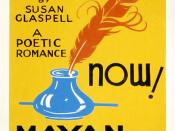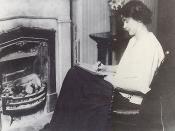Less May Be More In Susan Glaspell?s play , Trifles, the title takes a significant role as the story progresses.
The title, Trifles, makes an appearance in the play and lets the audience see and feel how the title takes a hold of the story. The characters and their attitudes also help depict what trifling is and help to define a subjective meaning in the story. The author accurately appeals to the reader?s senses and allows them to engage in the story. The reader can unfold the story in his or her own mind and interpret how Trifles reflects the story. Glaspell tells the story to prove that sometime the small, trifling things are what matter the most.
The importance of the title in Glaspell?s play should be held high. The entire story boils down to the helpfulness of trifling things. In the story, Glaspell cannot use cold, hard facts because it is a fictional play.
Therefore, Glaspell cannot directly apply an appeal to the facts. Instead, Glaspell indirectly using the facts that are presented as the story is told. Even though the play is not real, the appeal to the facts is successfully used as readers can develop their aspect of the mystery and a picture of what is occurring as the play progresses. A woman is being investigated in the murder of her husband. As the investigation is taking place and questions are being asked in the story, questions are being aroused in our minds. Did the man hang himself or did his wife do it? Was it someone else and why? The reader can evaluate the facts that are given and draw a conclusion based on their knowledge gained that the author has provided. The facts in Coplan 2 the story are what hold the piece together. The story comes together and all makes sense due to the way Glaspell puts all the facts in order and to good use. The conclusion of Trifles is based on the information given to the reader. If the appeal to facts was not given to the audience, the play would never be able to sustain it?s basis. Glaspell exhibits her ability of appeal in several different ways.
Another useful appeal that is used throughout the play is the emotional hold that the author gives to her audience. The reader is allowed to sympathize with the situation at hand and pushed to conclude feelings of some sorts towards either the characters or the situations they are being put through. Glaspell brings emotion into the play by drawing out the feelings of the reader. By making the mystery a murder, the story becomes more intimate. Arguably the worst thing that could happen to a person, murder, Glaspell uses the delicate scenario to make the reader become emotionally involved in the story. Through the duration of the story the feelings of the characters lean our views toward the plot. The woman who is being investigated for the murder of her husband takes a very shallow and almost absent frame of being. As readers notice the woman?s vague mood they start to get a sorrowful taste of the setting. The emotion takes the reader through the play. The characters acting or feeling a certain way change the mood of the story, thus changing the reader?s mood. The men bring an audacious tone into the play and carry it with them. The women interpret a lighter intuition among the play that seems to rise as the story starts to settle. As the play begins to close and the pain of murder continues to guide the tone, the mood turns towards a lighter scene. The women that are at the house with the men use their trifling discoveries to crack the case of the murder, but decide to hide the finding for the sake of the well being of the investigated woman. The author brightens the view of the story to give a resolution Coplan 3 to the discovery of the mystery. Glaspell's use of descriptive language and subtle hints established the mood, presents the motive, and uncovers the evidence needed to solve this murder mystery.
Along with the title helping define the story itself, Trifles also helps to portray the characters beyond the play. The reader can vividly see how each of the characters act in the story. The men are very arrogant and deem the woman as being trifling. Solving the case is what the men are there to do, they have everything handled with precision. ?Well, women are used to worrying about trifles,? one of the men, Hale, remarks to acknowledge that the women are not focused on what is important, but on the smaller, more insignificant things. The entire story shows the men handling everything just for the simple fact that they are men and that is what they are suppose to do. Letting the women sit to meddle amongst themselves is what they are suppose to do right? In the beginning the women were merely shown and written off as trifles of the story. At this point, the reader can incorporate the title with the female characters of the play. While the play continues, Glaspell begins to even the score of importance of presence between the males and the females. The men began as the dominance, and ignore the perspectives of the women. Towards the end, the male figures became less and less critical to solving the murder case, while the women begin to draw the attention of the reader to them. The author makes this happen by turning the focus of the investigation to the women. Even though the women are just wondering about, their discoveries, as minute as they may seem, deliver more essential information than anything them men have pursued. At the end of the story, a dead bird in a box is the key to the entire mystery of the play. The dead bird was one of the trifling pieces of evidence that the women had found. To the men, the trifling bits the women were pondering over were of no concern. In the story the men were of no help in solving the case. This aspect of the men made them take the Coplan 4 title, Trifles. The role reversal made the women the key players in solving the mystery. Glaspell uses this notion to guide the play to a point that she wants to prove. To show that you can never overlook the little things was the point that was being conveyed.
The title, Trifles, of Glaspell?s play can be taken into many different insights. In the story the title represents the actual on goings of the play. The characters also take the title and in a way personify it?s meaning. The female side is directly stated as trifling by the male characters in the story. On the other hand, by the end of the play what the men are doing is trifling to the outcome of the play itself, but not the meaning or moral of the piece. I believe that Glaspell does a wonderful job of delivering a message in a manor other than blatant. Sometimes hidden terms can grasp an attention more than a direct approach. Certain people will interpret Glaspell?s title in different ways ,but whether you see the men or the women in the story as the trifle, the message attempted remains the same. Sometimes the small, seemingly unimportant things are the biggest help of all.





